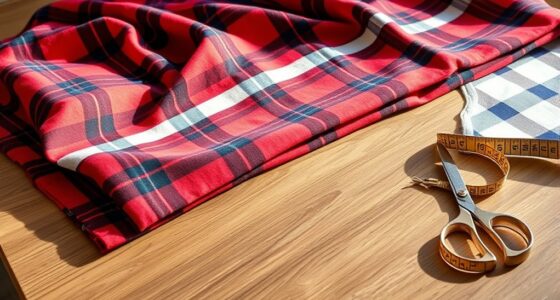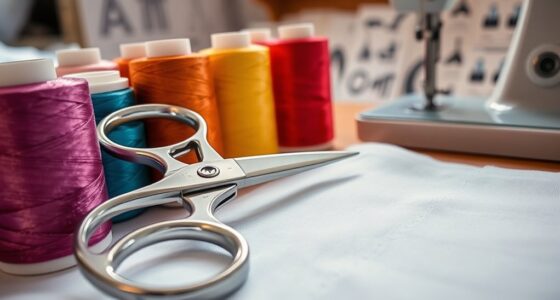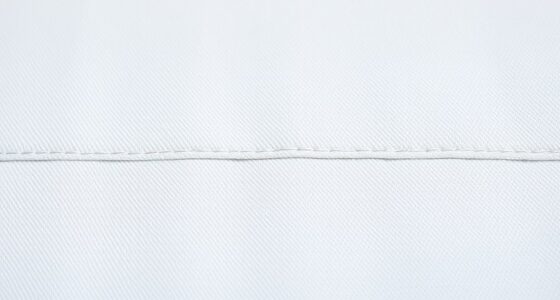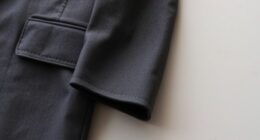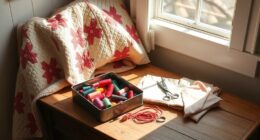To achieve flawless upcycling, embrace your creativity by viewing everyday items as treasures waiting to be transformed. Use essential tools like a power sander and utility knife for a polished finish. Prioritize durable materials and consider their potential for restoration. Experiment with color and texture to enhance aesthetics, and don't shy away from mistakes; they're opportunities for learning. Interested in more expert tips and techniques to elevate your projects? There's plenty more to discover!
Key Takeaways
- Use high-quality primers and paints to enhance color vibrancy and ensure a long-lasting finish on upcycled items.
- Experiment with various distressing techniques to achieve a rustic, unique look that showcases character and creativity.
- Prioritize sourcing durable materials and assessing their restoration potential for successful transformations.
- Take advantage of online resources and tutorials to gain confidence and discover innovative upcycling ideas before starting projects.
- Celebrate mistakes as learning opportunities, allowing for unexpected creative solutions that can enhance your upcycling journey.
Embracing Creativity in Upcycling Projects

Have you ever looked at an old chair and seen more than just worn-out furniture? Embracing creativity in upcycling projects means viewing everyday items as potential treasures, ready for transformation.
You can discover tips and tricks by exploring unique materials from thrift stores or scrapyards that spark new ideas. Don't hesitate to experiment with techniques like distressing or applying gold leaf—these can give your projects a distinctive flair.
Engaging with online platforms like YouTube and Pinterest can inspire you and build your confidence. And remember, celebrating mistakes is part of the process; they often lead to creative solutions and learning opportunities. Additionally, budgeting for your upcycling projects can ensure you stay on track financially while pursuing your creative passions, making it essential to have a clear budget plan in place.
Essential Tools for Successful Upcycling
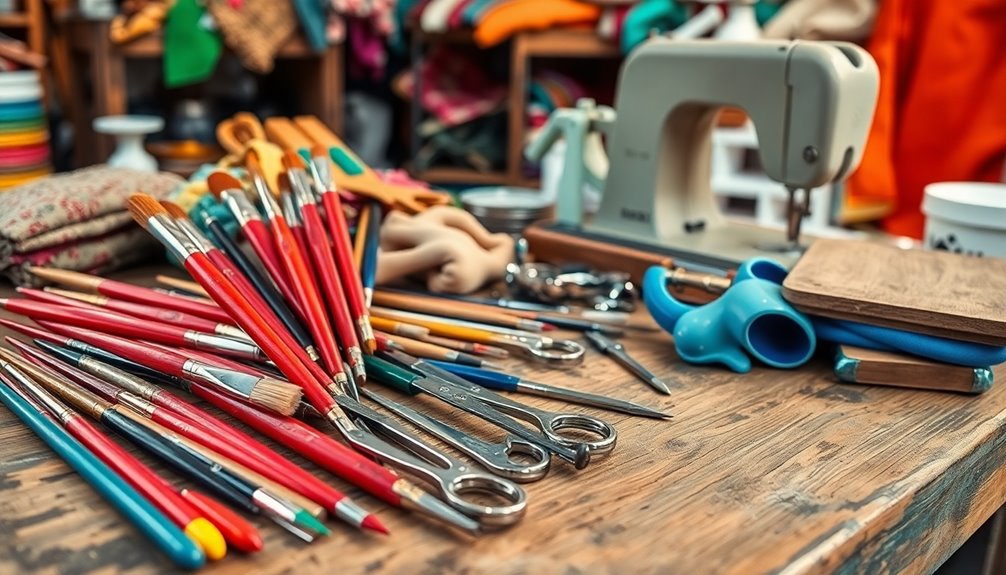
To tackle your upcycling projects successfully, you need the right tools at your fingertips.
A well-equipped toolkit and essential safety gear will help you navigate repairs and transformations with ease.
Let's explore the must-have tools and safety equipment that'll make your upcycling experience both effective and enjoyable.
Must-Have Tools
Upcycling projects can be incredibly rewarding, but having the right tools makes all the difference. A power sander will help you smooth surfaces for a polished finish, while a versatile utility knife guarantees precise cuts for clean edges.
You'll also want a staple gun for securing fabrics and a paintbrush to apply your finishes. Don't forget a good set of screwdrivers—both flathead and Phillips—essential for disassembling furniture or making repairs.
To maintain accuracy in your designs, a measuring tape and square are must-haves. With these tools in your arsenal, you'll elevate your upcycling game and create stunning, tailored pieces that reflect your creativity. Additionally, understanding proper care for your materials ensures that your upcycled creations last longer and look even better.
Get ready to transform those materials into something special!
Safety Equipment Essentials
When diving into your next upcycling project, prioritizing safety equipment is essential for a successful and enjoyable experience.
Always wear safety goggles to shield your eyes from dust and debris while sanding or cutting materials. A dust mask or respirator is vital when working with substances that generate dust or fumes, particularly during painting or adhesive use.
Invest in a good pair of work gloves to protect your hands from sharp edges, splinters, and harmful chemicals. Keep a first aid kit handy for any minor injuries that might occur.
Finally, don't forget a fire extinguisher, especially when working with flammable materials like spray paints or solvents in enclosed spaces.
Stay safe and enjoy your upcycling journey!
Techniques for Transforming Everyday Items
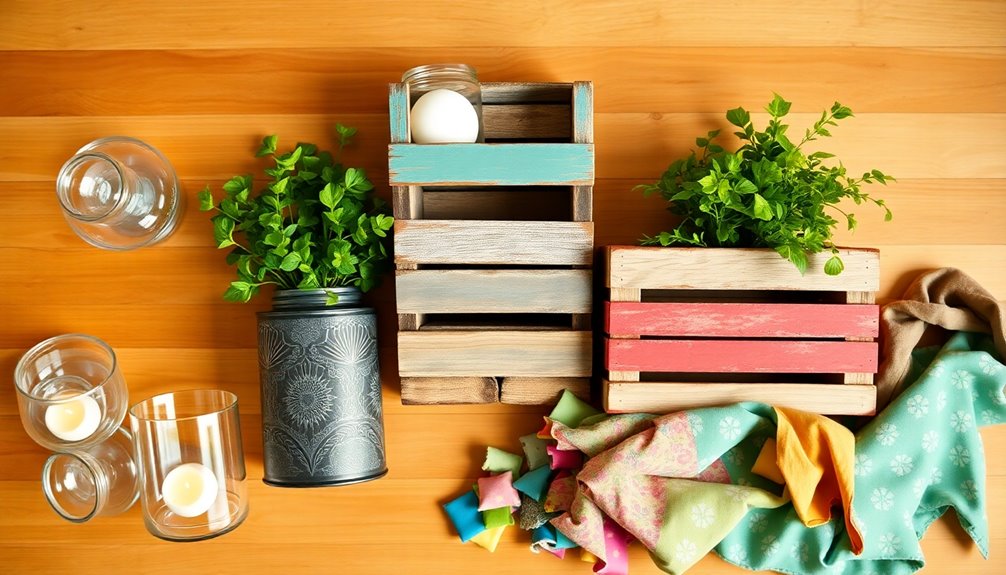
When transforming everyday items, choosing the right materials can make all the difference in your project's outcome.
You'll want to gather essential tools that streamline your process and elevate your design techniques.
Choosing the Right Materials
Choosing the right materials can make all the difference in your upcycling projects. Start by prioritizing durable items like solid wood, metal, or high-quality fabrics—they'll withstand transformations better and last longer.
Look for versatile pieces, such as an old wooden ladder that can become a bookshelf for your living room or a vintage suitcase turned unique storage solution.
Assess the condition of your materials; minor wear and tear is often easy to restore, while severely damaged items may demand more effort.
Don't forget the aesthetic appeal—interesting textures and patterns can elevate your projects.
Finally, think outside the box; unconventional materials, like repurposed doors or glass jars, can inspire you to create something truly innovative. Additionally, being aware of symptoms of breast cancer can encourage you to consider health and safety when working with reclaimed materials.
Essential Tools for Success
Having the right materials sets the stage for your upcycling projects, but without the proper tools, those ideas mightn’t come to life as envisioned. To effectively transform your materials into stunning creations, a solid toolkit is essential. This doesn’t mean you need to invest in expensive equipment; even basic tools can help you execute your vision with precision. When you’re equipped, exploring beginner upcycling project ideas becomes an exciting endeavor that allows your creativity to flourish while promoting sustainability.
Start with a quality paintbrush set for smooth applications, and don't underestimate the versatility of a multi-tool for various tasks. A basic sewing kit can elevate your projects, too.
For a professional finish, use sandpaper or a sanding block to smooth surfaces before painting. A hot glue gun offers quick, strong bonding for creative combinations.
Precision is key, so a rotary cutter and cutting mat will help you achieve clean lines.
Finally, always prioritize safety by wearing gloves and goggles when working with tools and chemicals. Remember that incorporating bold colors can enhance the overall aesthetic of your upcycled items.
Happy upcycling!
Creative Design Techniques
Upcycling opens up a world of creative design techniques that can breathe new life into everyday items.
By experimenting with various methods, you can transform the ordinary into extraordinary. Here are a few ideas to inspire you:
- Distressing Techniques: Use sanding or vinegar to give furniture a vintage look, adding character and charm.
- Metallic Accents: Incorporate gold leaf or metallic paints to highlight edges, elevating the visual appeal of simple objects.
- Reupholstering: Breath life into tired furniture by using fabric remnants or old linens, adding vibrant color and texture.
These creative design strategies not only enhance your space but also showcase your unique style while promoting sustainability. Additionally, consider incorporating distressed finishes in your projects for a more authentic farmhouse aesthetic.
Immerse yourself in upcycling and watch your creativity flourish!
Sourcing Unique Materials for Your Creations
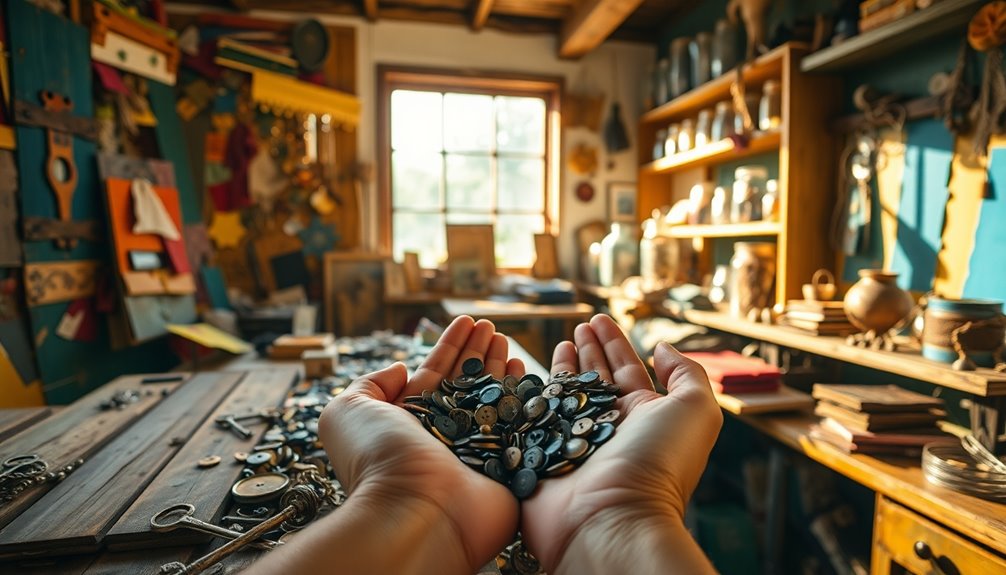
While you might think sourcing materials for your upcycling projects is a challenging task, the truth is that inspiration often lurks in the most unexpected places.
Thrift stores are excellent spots to discover unique finds, offering everything from old furniture to quirky decorative pieces. Local yard sales and flea markets are gold mines for affordable materials that can be transformed into stunning creations.
Don't overlook salvage yards, where you'll encounter unconventional materials like metal scraps and wood that add character to your projects. Online marketplaces like Facebook Marketplace or Craigslist can also yield unique finds from folks decluttering their homes.
Finally, keep an eye out during bulk waste collection days; discarded items can be salvaged and given new life! Additionally, consider tax implications when assessing the value of your upcycled creations to ensure you're maximizing your efforts.
Tips for Repairing and Restoring Furniture
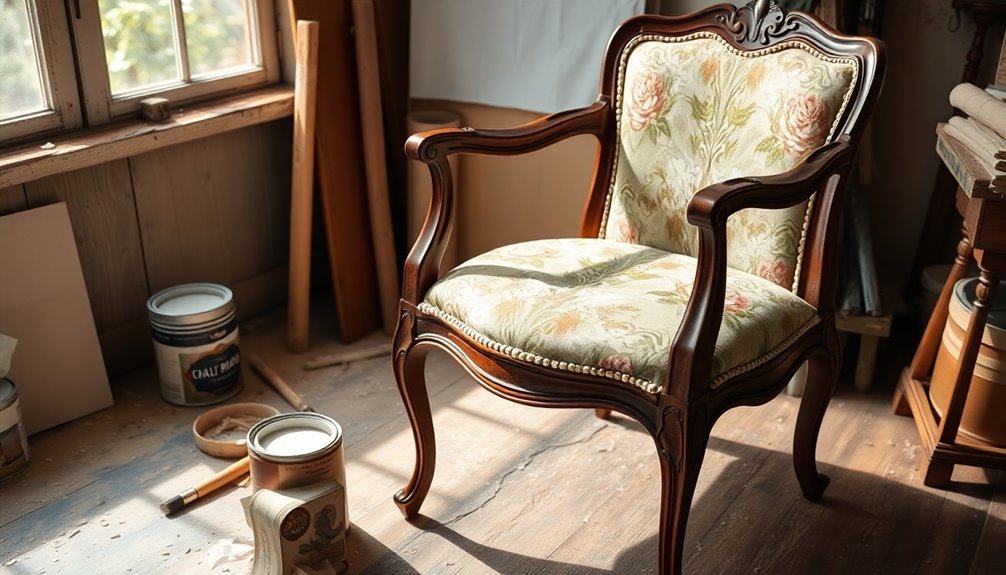
When you tackle the task of repairing and restoring furniture, a careful assessment of its condition is essential.
You'll want to find exactly what needs fixing before diving into cosmetic updates. Here are three key steps to follow:
- Check for Structural Issues: Look for loose joints and fix them with wood glue or clamps.
- Prep the Surface: Use high-quality sandpaper to smooth surfaces, ensuring your paint or stain adheres better.
- Choose Hardware Wisely: When replacing knobs or hinges, select pieces that complement the furniture's style; vintage options can add something new and unique. Additionally, consider the influence of family background on your design choices, as it can inspire unique restoration ideas.
Enhancing Aesthetics With Color and Texture

To truly elevate your upcycled furniture, enhancing aesthetics with color and texture is key. Start by using a high-quality primer to create a smooth surface and boost color vibrancy. Experiment with various textures, such as fabric or stencils, to add visual interest. Incorporating gold leaf accents can also lend sophistication to your projects. Additionally, consider using calming color schemes inspired by nature to promote tranquility in your space.
Here's a quick reference table for effective color schemes and textures:
| Color Schemes | Textures |
|---|---|
| Complementary colors | Distressing techniques |
| Monochromatic palettes | Fabric overlays |
| Triadic color choices | Layered paint finishes |
Layering different paint finishes can create striking contrasts, highlighting features and enhancing the overall appeal of your upcycled furniture.
Building a Community Around Upcycling
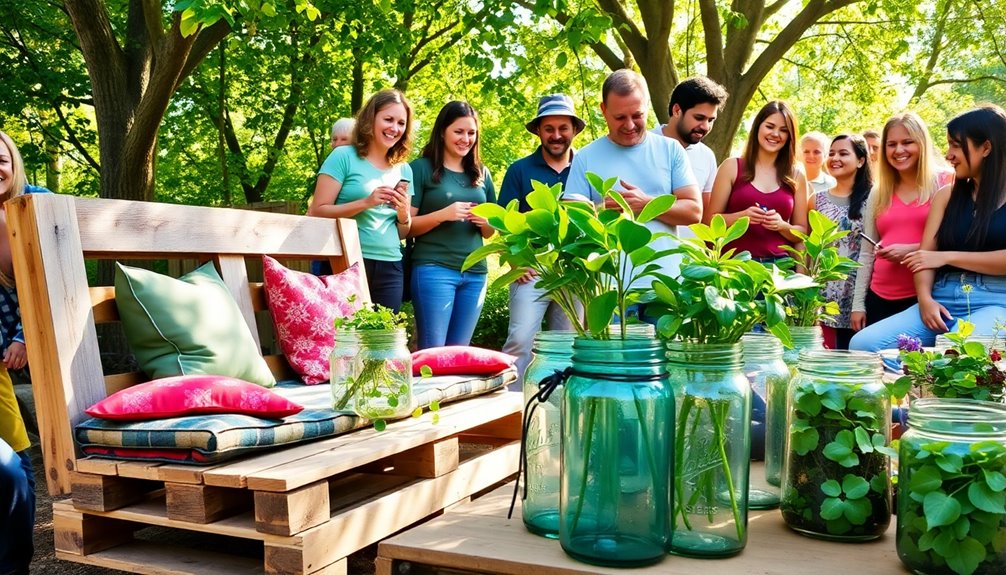
Creating a vibrant community around upcycling enriches the experience for everyone involved.
By connecting with others who share your passion, you'll access valuable resources and support.
Here are three ways to foster this community:
- Host Workshops and Meetups: Organize local gatherings where you can share skills and ideas, promoting collaboration.
- Leverage Online Platforms: Join social media groups dedicated to upcycling, allowing you to showcase projects and exchange tips.
- Create a Tool Library: Establish a community library for sharing tools and materials, making it easier for everyone to access what they need without spending money.
Additionally, engaging in community projects can enhance fuel injection cleaning knowledge and practices, benefiting both experienced upcyclers and newcomers alike.
Frequently Asked Questions
What Upcycled Items Sell Best?
When you're looking at upcycled items that sell best, focus on vintage furniture and mid-century modern pieces, which are always in demand.
Unique home decor, like wall art made from reclaimed wood or repurposed glass lighting, attracts buyers seeking sustainability.
Additionally, clothing items made from upcycled fabrics, such as tote bags or jackets, have gained popularity.
Functional pieces, like garden planters or storage solutions, also appeal to those interested in practical yet stylish options.
What Grit Sandpaper for Upcycling?
Imagine you're transforming an old wooden chair into a stunning piece for your dining room.
For upcycling projects like this, you'll want to start with medium grit sandpaper, around 120 to 180 grit, to smooth the surface without losing too much material.
Use coarser sandpaper, like 80 grit, for initial shaping, then finish with finer grit, 220 and above, for a polished look.
Always sand with the wood grain and wear protective gear for safety!
What Is the Main Disadvantage of Upcycling?
The main disadvantage of upcycling is that it can be time-consuming.
You'll often find yourself spending significant time planning, sourcing materials, and executing your projects.
If you're a beginner, you might feel overwhelmed by the complexity of certain tasks that require specific tools and skills.
Additionally, the inconsistency in the quality of salvaged materials can limit your options and lead to unmet expectations, making it challenging to achieve your desired results.
Can You Make Money From Upcycling?
Yes, you can definitely make money from upcycling!
By transforming old materials into unique products, you create items that people are willing to pay a premium for.
With platforms like Etsy and eBay, you've got a wide audience enthusiastic for sustainable and creative goods.
The more skilled you become, the higher your profit margins can be.
Plus, building a personal brand around your creations can further enhance your sales opportunities.
Conclusion
As you immerse yourself in the world of upcycling, remember that every discarded item holds the potential for transformation, much like a butterfly emerging from its chrysalis. Embrace your creativity, gather your tools, and don't shy away from experimenting. By breathing new life into the old, you're not just crafting unique pieces; you're also nurturing a sustainable future. So, roll up your sleeves, release your imagination, and let each project tell its own story. Happy upcycling!


